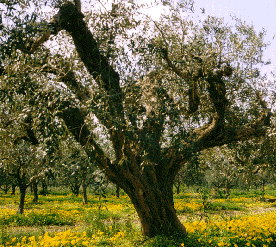...Best of Sicily presents... Best of Sicily Magazine. ... Dedicated to Sicilian art, culture, history, people, places and all things Sicilian. |
by Maria Mazzaro | |||
Magazine Index Best of Sicily Arts & Culture Fashion Food & Wine History & Society About Us Travel Faqs Contact Map of Sicily
|
It is generally agreed that the wild olive (olea europea sylvestris) and its domesticated cousins originated in Asia Minor (now Turkey) or west-central Asia. Considering the vast variety of olives, and the exceptional longevity of olive trees, it is clear that the major differentiation of olive varieties took place as part of a long evolution tens of millennia ago. Initially, oleasters were probably the only olive trees present in Sicily. Though wild olive trees yield a small fruit, most botanists and historians believe that the Phoenicians or Greeks were probably the first to cultivate domesticated olives in Sicily, introducing varieties which produced larger edible fruit. This would not exclude the possibility that the Elymians (or even the native Sicanians) might have raised olives. Much of this is highly conjectural, but by the Greek era olives were common in Sicily. There is evidence to suggest that --at least initially-- Sicily's Greeks grafted branches of domesticated varieties onto wild rootstocks. Domesticated olive trees seem to live longer than oleasters. Some olive trees are a thousand years old, and several in Sicily are thought to be at least five centuries old. Oleasters are superficially similar to the short olive trees grown in Sicily, and compatible with them from that point of view. They still grow wild in some areas, particularly in rocky terrain that is not easily accessible. While oleasters are few, Italian law presently does not identify them as a protected species. Perhaps it should. Like olive trees, oleasters have a slightly blue-green color when viewed from a distance. Their leaves are similar in shape, texture and color to those of domesticated olives, though typically slightly smaller. Oleasters can tolerate cold so long as the ground doesn't freeze. They thrive in all but the highest regions of the Madonie and Nebrodi mountains and the higher slopes of Mount Etna, and in the past were found throughout southern Italy as well as in parts of Greece, Turkey and the Middle East. About the Author: Maria Mazzaro writes about environmental topics. | ||
Top of Page |
 The oleaster is a wild olive tree of the genus olea (though
the word "oleaster" also refers to various unrelated Mediterranean
shrubs of the genus eleagnus that produce small fruits). Olive trees,
wild or not, are in the family oleaceae and the genus olea.
Olive pits (stones) have been discovered in sites inhabited around 10,000
BC (BCE). As far as we know, domestication of olives probably did not occur
much before 4000 BC.
The oleaster is a wild olive tree of the genus olea (though
the word "oleaster" also refers to various unrelated Mediterranean
shrubs of the genus eleagnus that produce small fruits). Olive trees,
wild or not, are in the family oleaceae and the genus olea.
Olive pits (stones) have been discovered in sites inhabited around 10,000
BC (BCE). As far as we know, domestication of olives probably did not occur
much before 4000 BC.